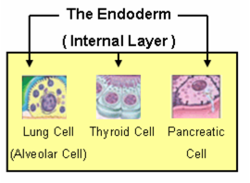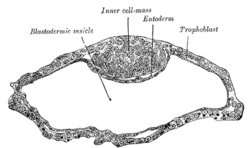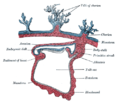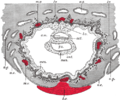Endoderm
| Endoderm | |
|---|---|
 Organs derived from endoderm. | |
 Blastodermic vesicle of Vespertilio murinus. (Endoderm labeled as 'entoderm'.) | |
| Details | |
| Days | 16 |
| Precursor | hypoblast |
| Gives rise to | splanchnopleure |
| Identifiers | |
| MeSH | D004707 |
| FMA | 69071 |
| Anatomical terminology | |
Endoderm is one of the germ layers formed during animal embryogenesis. Cells migrating inward along the archenteron form the inner layer of the gastrula, which develops into the endoderm.
The endoderm consists at first of flattened cells, which subsequently become columnar. It forms the epithelial lining of the whole of the digestive tube except part of the mouth,pharynx and the terminal part of the rectum (which are lined by involutions of the ectoderm), the lining cells of all the glands which open into the digestive tube, including those of the liver and pancreas, the epithelium of the auditory tube and tympanic cavity, of the trachea, bronchi, and air cells of the lungs, of the urinary bladder and part of the urethra, and that which lines the follicles of the thyroid gland and thymus.
Production
The following graph represents the products produced by the endoderm.
| Germ Layer | Category | Product |
|---|---|---|
| Endoderm | General[1] | Gastrointestinal tract |
| Endoderm | General | Respiratory tract |
| Endoderm | General | Endocrine glands and organs (liver and pancreas) |
Additional images
-
Section through the embryo.
-
Section through ovum imbedded in the uterine decidua
See also
Notes
References
- Evers, Christine A., Lisa Starr. Biology:Concepts and Applications. 6th ed. United States:Thomson, 2006. ISBN 0-534-46224-3.
Template:Germ layer
![]() This article incorporates text in the public domain from page 49 of the 20th edition of Gray's Anatomy (1918)
This article incorporates text in the public domain from page 49 of the 20th edition of Gray's Anatomy (1918)


